TS
madokaichi
ALL ABOUT VIETNAM WAR 1950 - 1975
This massive North Vietnamese surprise attack during the 1968 Tet holiday was a crucial turning point in the war.


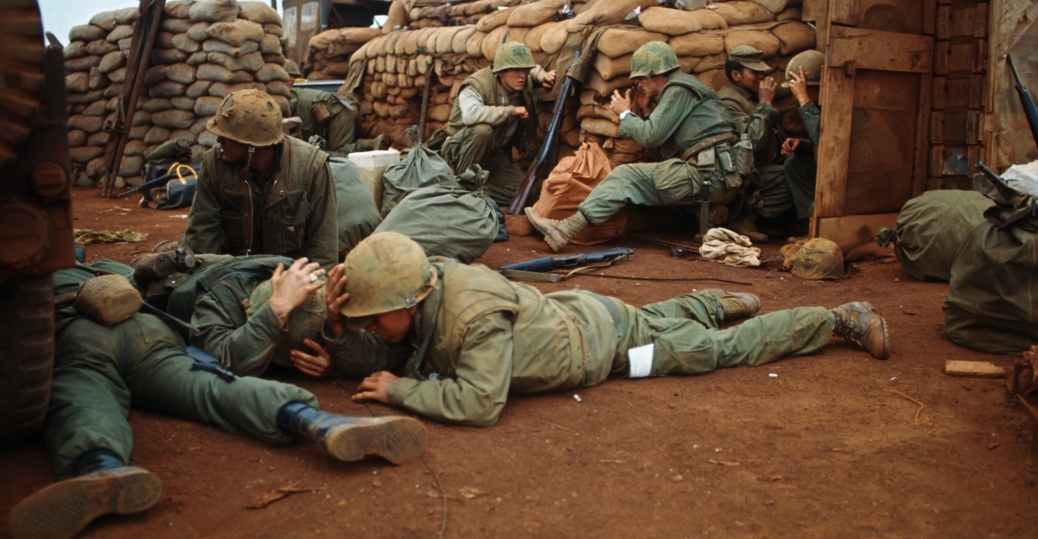
On January 31, 1968, approximately 70,000 North Vietnamese and Viet Cong forces began a series of attacks on the U.S. and South Vietnamese.

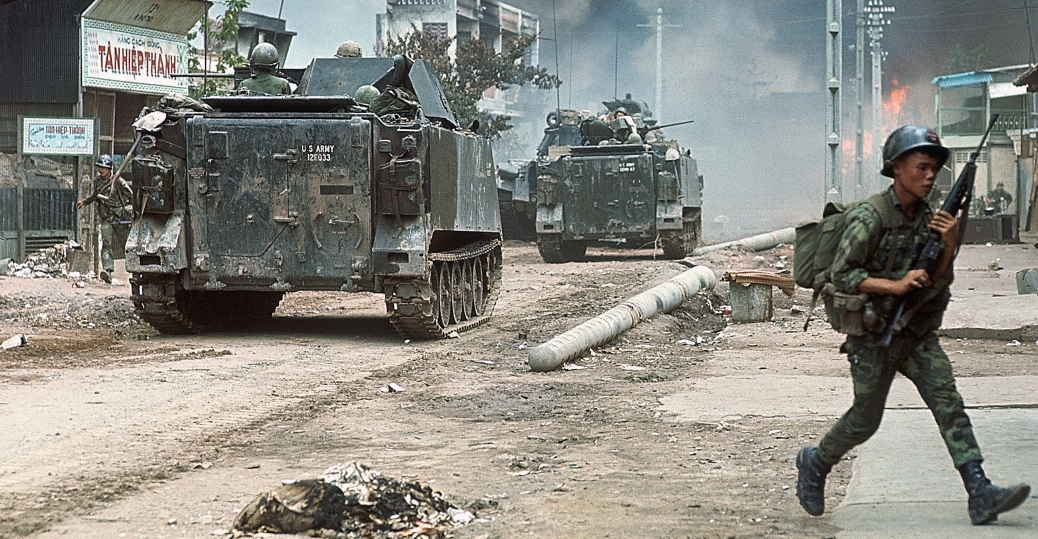
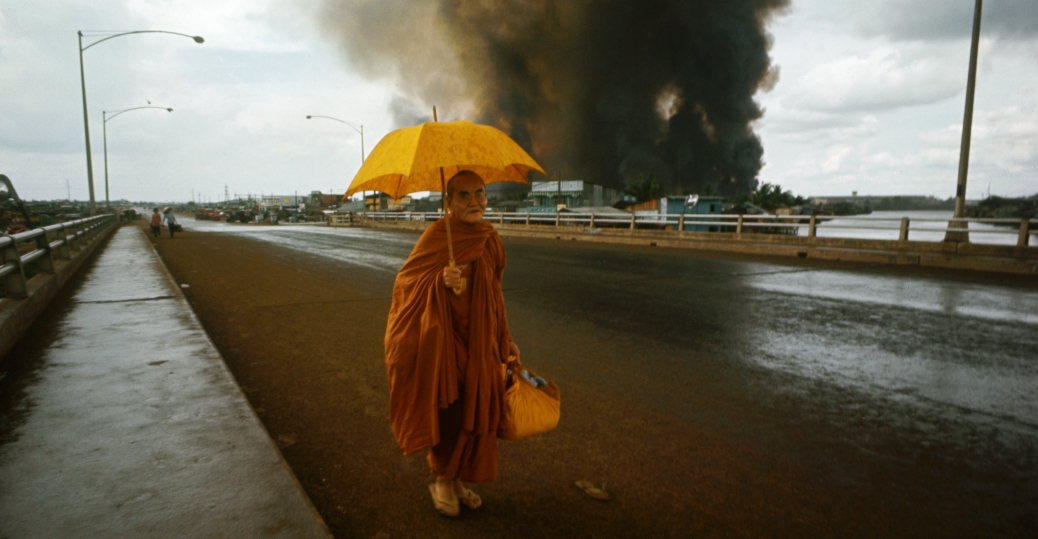
On the first day of the attacks, a Buddhist monk flees the damage and destruction behind him.
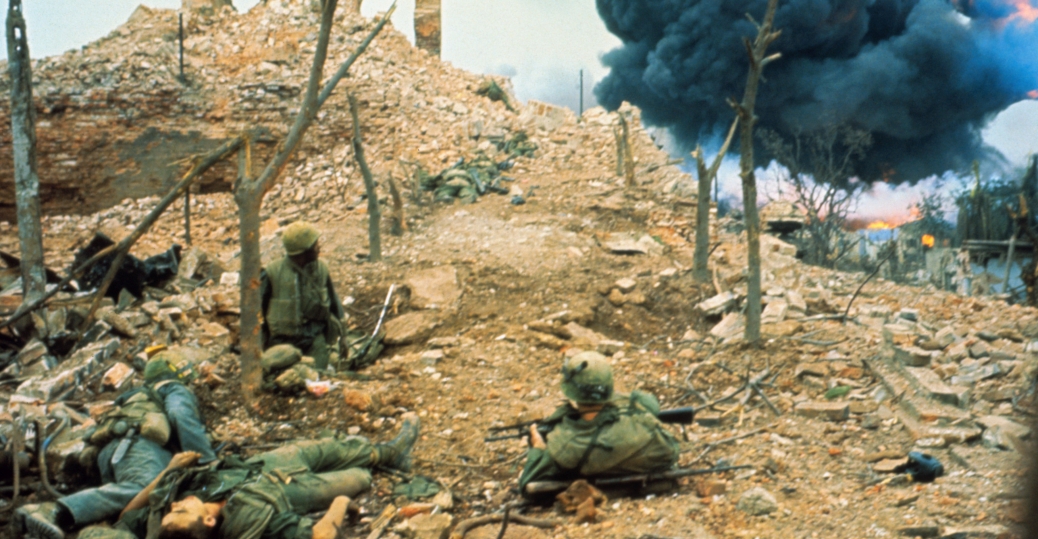
U.S. forces are posted at the outer wall of a citadel in the ancient city of Hue, the scene of the fiercest fighting of the Tet Offensive.
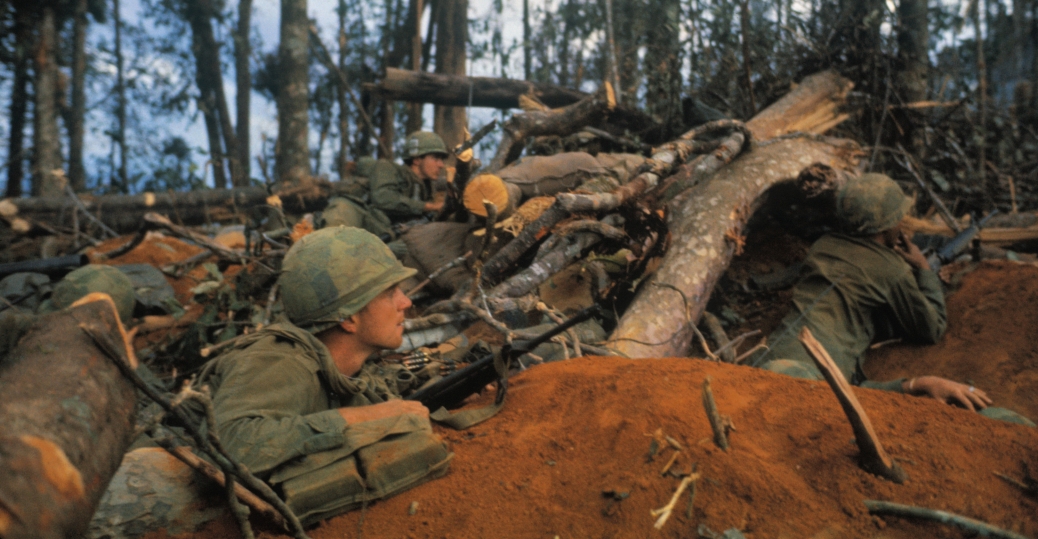
Approximately 150 U.S. Marines were killed along with 400 South Vietnamese troops at the Battle of Hue.

A wounded soldier is dragged to safety near the citadel’s outer wall during the fighting at Hue.
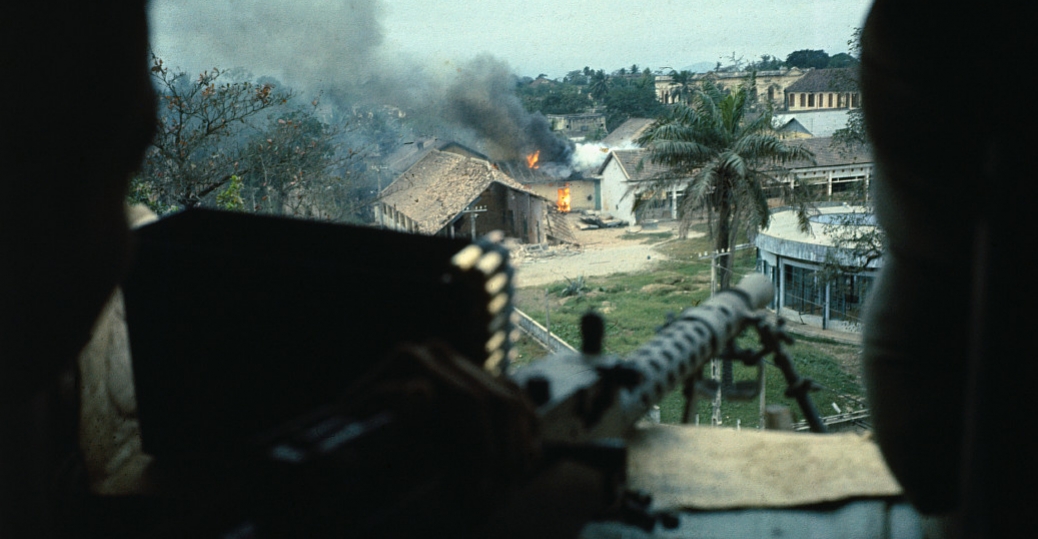

Military policemen capture a Viet Cong guerrilla after the surprise attack on the U.S. embassy and South Vietnamese government buildings in Saigon.
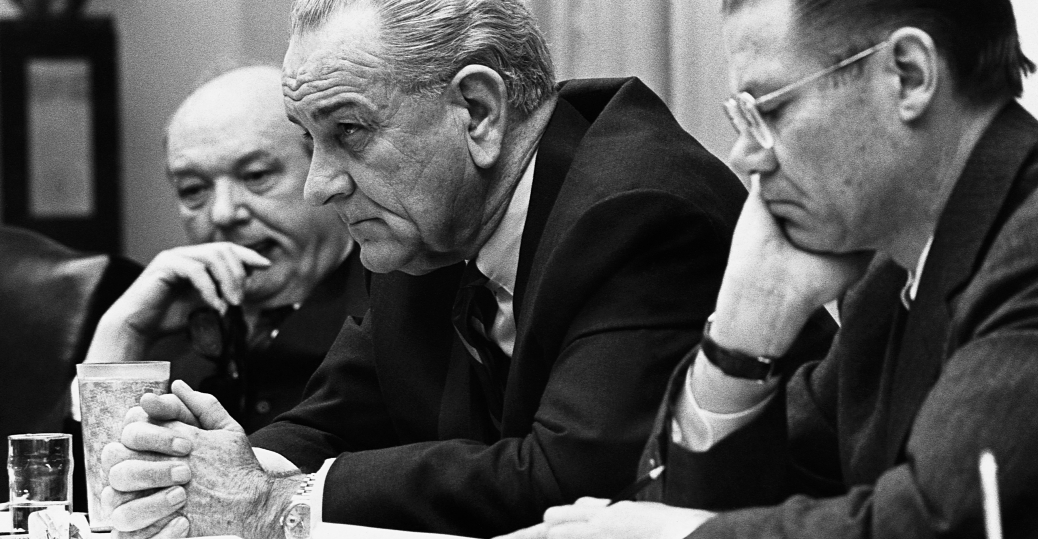
President Johnson meets with Secretary of Defense Robert McNamara and other advisors following the Tet Offensive, which marked a crucial turning point in America’s involvement in the war.
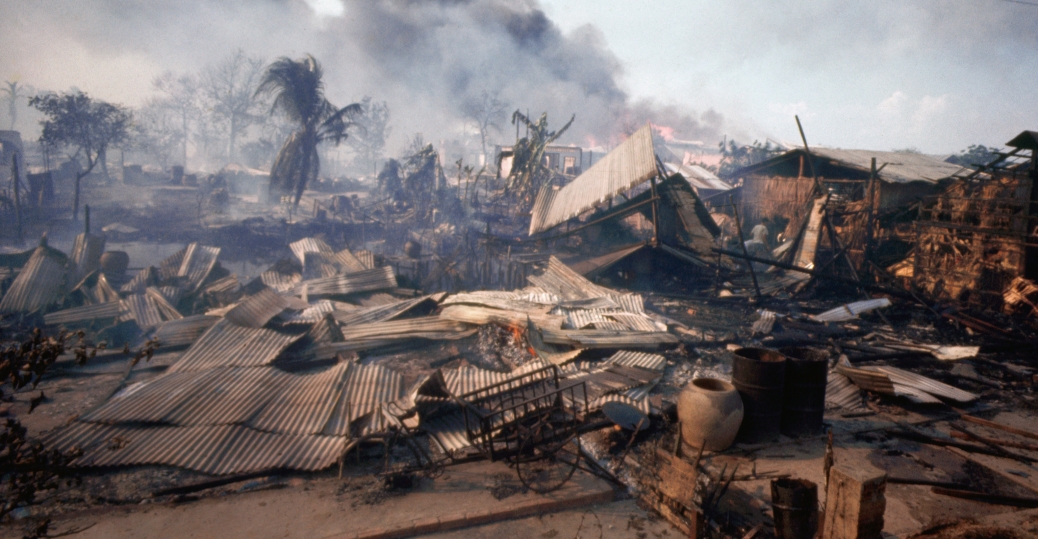
A market in the Cholon District of Saigon is covered in smoke and debris after the Tet Offensive, which included simultaneous attacks on more than 100 South Vietnamese cities and towns.
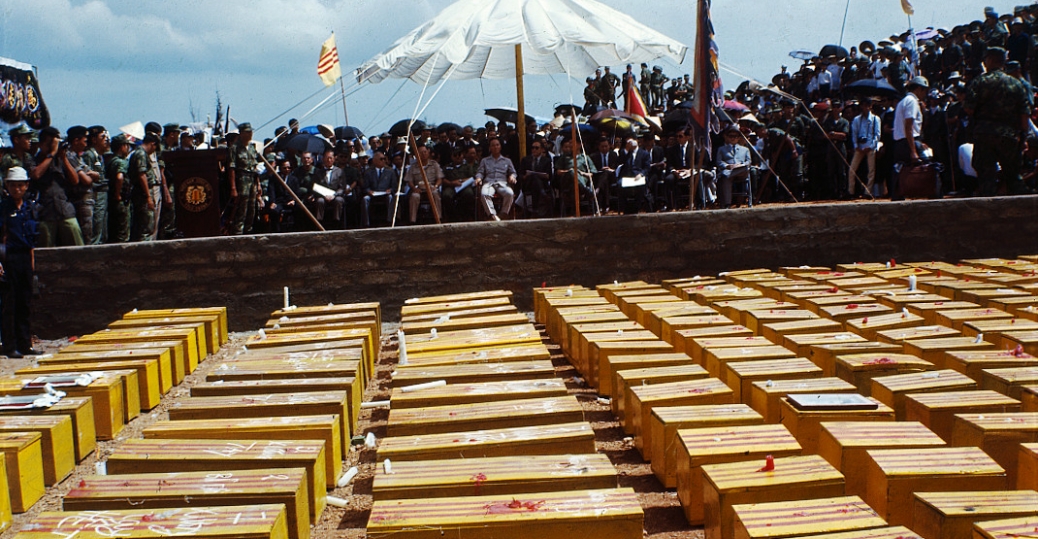
In October 1969, relatives gather at a mass funeral for recently-discovered victims of the Tet Offensive.

South Vietnamese President Nguyen Van Thieu speaks at the funeral for those killed.
On January 31, 1968, some 70,000 North Vietnamese and Viet Cong forces launched the Tet Offensive (named for the lunar new year holiday called Tet), a coordinated series of fierce attacks on more than 100 cities and towns in South Vietnam. General Vo Nguyen Giap, leader of the Communist People’s Army of Vietnam (PAVN), planned the offensive in an attempt both to foment rebellion among the South Vietnamese population and encourage the United States to scale back its support of the Saigon regime. Though U.S. and South Vietnamese forces managed to hold off the Communist attacks, news coverage of the offensive (including the lengthy Battle of Hue) shocked and dismayed the American public and further eroded support for the war effort. Despite heavy casualties, North Vietnam achieved a strategic victory with the Tet Offensive, as the attacks marked a turning point in the Vietnam War and the beginning of the slow, painful American withdrawal from the region.
GOALS OF THE TET OFFENSIVE
As the celebration of the lunar new year, Tet was the most important holiday on the Vietnamese calendar. In previous years, the holiday had been the occasion for an informal truce in South Vietnam’s long-running conflict with North Vietnam and their Communist southern allies, derisively known as Viet Cong. In early 1968, however, the North Vietnamese military commander General Vo Nguyen Giap chose January 31 as the occasion for a coordinated offensive of surprise attacks aimed at breaking the stalemate in Vietnam. Giap believed that the attacks would cause Army of the Republic of Vietnam (ARVN) forces to collapse and foment discontent and rebellion among the South Vietnamese population, leading them to rise up against the regime in Saigon. Futhermore, Giap believed the alliance between South Vietnam and the United States was unstable; he hoped the offensive would drive the final wedge between them and convince American leaders to give up their defense of South Vietnam.
In February 1968, in the wake of the Tet Offensive, the respected TV journalist Walter Cronkite, who had been a moderate and balanced observer of the war's progress, announced that it seemed "more certain than ever that the bloody experience of Vietnam is to end in a stalemate."
In preparation for the planned offensive, Communist troops launched a series of attacks in the fall of 1967 on isolated American garrisons in the highlands of central Vietnam and along the Laotian and Cambodian frontiers. On January 21, 1968, PAVN forces began a massive artillery bombardment of the U.S. Marine garrison at Khe Sanh, located on the principal road from northern South Vietnam into Laos. As President Lyndon Johnson and General William Westmoreland focused their attention on the defense of Khe Sanh (a battle whose importance was compared to that of the doomed French struggle for Dien Bien Phu in 1954), Giap’s 70,000 poised to begin their real objective: the Tet Offensive.
TET OFFENSIVE BEGINS
On the early morning of January 30, 1968, Viet Cong forces attacked 13 cities in central South Vietnam, just as many families began their observances of the lunar new year. Twenty-four hours later, PAVN and Viet Cong forces struck a number of other targets throughout South Vietnam, including cities, towns, government buildings and U.S. or ARVN military bases throughout South Vietnam, in a total of more than a hundred attacks. In a particularly bold attack on the U.S. embassy in Saigon, a Viet Cong platoon got inside the complex’s courtyard before U.S. forces destroyed it. The attack’s audacity, and its initial success, stunned U.S. and international observers, who saw images of the carnage broadcast on television as it occurred.
Though Giap had succeeded in achieving surprise, his forces were spread too thin in the ambitious offensive, and U.S. and ARVN forces managed to successfully counter most of the attacks and inflict heavy Viet Cong losses. Particularly intense fighting took place in the city of Hue, located on the Perfume River some 50 miles south of the Demilitarized Zone (DZ) between North and South Vietnam. The Battle of Hue would rage for more than three weeks after PAVN and Viet Cong forces burst into the city on January 31, easily overwhelming the government forces there and taking control of the city’s ancient citadel.
THE BATTLE OF HUE
Early in their occupation of Hue, Viet Cong soldiers conducted house-to-house searches, arresting civil servants, religious leaders, teachers and other civilians connected with American forces or with the South Vietnamese regime. They executed these so-called counterrevolutionaries and buried their bodies in mass graves. U.S. and ARVN forces discovered evidence of the massacre after they regained control of the city on February 26. In addition to more than 2,800 bodies, another 3,000 residents were missing, and the occupying forces had destroyed many of the once-grand city’s temples, palaces and other monuments.
The toughest fighting in Hue occurred at the citadel, which the Communists struggled fiercely to hold against superior U.S. firepower. In scenes of carnage recorded on film by numerous television crews on the scene, nearly 150 U.S. Marines were killed in the Battle of Hue, along with some 400 South Vietnamese troops. On the Communist side, an estimated 5,000 soldiers were killed, most of them hit by American air and artillery strikes.
IMPACT OF THE TET OFFENSIVE
Despite its heavy casualty toll, and its failure to inspire widespread rebellion among the South Vietnamese, the Tet Offensive proved to be a strategic success for the DRV. Before Tet, Westmoreland and other representatives of the Johnson administration had been claiming that the end of the war was in sight; now, it was clear a long struggle still lay ahead. Westmoreland requested more than 200,000 new troops in order to mount an effective counteroffensive, an escalation that many Americans saw as an act of desperation. As antiwar sentiment mounted on the home front, some of Johnson’s advisers that had supported past military buildup in Vietnam (including soon-to-be Secretary of Defense Clark Clifford) now argued for scaling back U.S. involvement.
On March 31, the beleaguered President Johnson declared that he was limiting the bombing of North Vietnam to the area below the 20th parallel (thus sparing 90 percent of Communist territory) and calling for negotiations to end the war. At the same time, he announced that he would not be running for reelection that November. Though peace talks would drag on for another five years–during which more American soldiers were killed than in the previous years of the conflict–Johnson’s decision to halt escalation after the Tet Offensive marked a crucial turning point in American participation in the Vietnam War.
http://www.history.com/topics/vietna...ng-vietnam-war


On January 31, 1968, approximately 70,000 North Vietnamese and Viet Cong forces began a series of attacks on the U.S. and South Vietnamese.


On the first day of the attacks, a Buddhist monk flees the damage and destruction behind him.

U.S. forces are posted at the outer wall of a citadel in the ancient city of Hue, the scene of the fiercest fighting of the Tet Offensive.

Approximately 150 U.S. Marines were killed along with 400 South Vietnamese troops at the Battle of Hue.

A wounded soldier is dragged to safety near the citadel’s outer wall during the fighting at Hue.


Military policemen capture a Viet Cong guerrilla after the surprise attack on the U.S. embassy and South Vietnamese government buildings in Saigon.

President Johnson meets with Secretary of Defense Robert McNamara and other advisors following the Tet Offensive, which marked a crucial turning point in America’s involvement in the war.

A market in the Cholon District of Saigon is covered in smoke and debris after the Tet Offensive, which included simultaneous attacks on more than 100 South Vietnamese cities and towns.

In October 1969, relatives gather at a mass funeral for recently-discovered victims of the Tet Offensive.

South Vietnamese President Nguyen Van Thieu speaks at the funeral for those killed.
On January 31, 1968, some 70,000 North Vietnamese and Viet Cong forces launched the Tet Offensive (named for the lunar new year holiday called Tet), a coordinated series of fierce attacks on more than 100 cities and towns in South Vietnam. General Vo Nguyen Giap, leader of the Communist People’s Army of Vietnam (PAVN), planned the offensive in an attempt both to foment rebellion among the South Vietnamese population and encourage the United States to scale back its support of the Saigon regime. Though U.S. and South Vietnamese forces managed to hold off the Communist attacks, news coverage of the offensive (including the lengthy Battle of Hue) shocked and dismayed the American public and further eroded support for the war effort. Despite heavy casualties, North Vietnam achieved a strategic victory with the Tet Offensive, as the attacks marked a turning point in the Vietnam War and the beginning of the slow, painful American withdrawal from the region.
GOALS OF THE TET OFFENSIVE
As the celebration of the lunar new year, Tet was the most important holiday on the Vietnamese calendar. In previous years, the holiday had been the occasion for an informal truce in South Vietnam’s long-running conflict with North Vietnam and their Communist southern allies, derisively known as Viet Cong. In early 1968, however, the North Vietnamese military commander General Vo Nguyen Giap chose January 31 as the occasion for a coordinated offensive of surprise attacks aimed at breaking the stalemate in Vietnam. Giap believed that the attacks would cause Army of the Republic of Vietnam (ARVN) forces to collapse and foment discontent and rebellion among the South Vietnamese population, leading them to rise up against the regime in Saigon. Futhermore, Giap believed the alliance between South Vietnam and the United States was unstable; he hoped the offensive would drive the final wedge between them and convince American leaders to give up their defense of South Vietnam.
In February 1968, in the wake of the Tet Offensive, the respected TV journalist Walter Cronkite, who had been a moderate and balanced observer of the war's progress, announced that it seemed "more certain than ever that the bloody experience of Vietnam is to end in a stalemate."
In preparation for the planned offensive, Communist troops launched a series of attacks in the fall of 1967 on isolated American garrisons in the highlands of central Vietnam and along the Laotian and Cambodian frontiers. On January 21, 1968, PAVN forces began a massive artillery bombardment of the U.S. Marine garrison at Khe Sanh, located on the principal road from northern South Vietnam into Laos. As President Lyndon Johnson and General William Westmoreland focused their attention on the defense of Khe Sanh (a battle whose importance was compared to that of the doomed French struggle for Dien Bien Phu in 1954), Giap’s 70,000 poised to begin their real objective: the Tet Offensive.
TET OFFENSIVE BEGINS
On the early morning of January 30, 1968, Viet Cong forces attacked 13 cities in central South Vietnam, just as many families began their observances of the lunar new year. Twenty-four hours later, PAVN and Viet Cong forces struck a number of other targets throughout South Vietnam, including cities, towns, government buildings and U.S. or ARVN military bases throughout South Vietnam, in a total of more than a hundred attacks. In a particularly bold attack on the U.S. embassy in Saigon, a Viet Cong platoon got inside the complex’s courtyard before U.S. forces destroyed it. The attack’s audacity, and its initial success, stunned U.S. and international observers, who saw images of the carnage broadcast on television as it occurred.
Though Giap had succeeded in achieving surprise, his forces were spread too thin in the ambitious offensive, and U.S. and ARVN forces managed to successfully counter most of the attacks and inflict heavy Viet Cong losses. Particularly intense fighting took place in the city of Hue, located on the Perfume River some 50 miles south of the Demilitarized Zone (DZ) between North and South Vietnam. The Battle of Hue would rage for more than three weeks after PAVN and Viet Cong forces burst into the city on January 31, easily overwhelming the government forces there and taking control of the city’s ancient citadel.
THE BATTLE OF HUE
Early in their occupation of Hue, Viet Cong soldiers conducted house-to-house searches, arresting civil servants, religious leaders, teachers and other civilians connected with American forces or with the South Vietnamese regime. They executed these so-called counterrevolutionaries and buried their bodies in mass graves. U.S. and ARVN forces discovered evidence of the massacre after they regained control of the city on February 26. In addition to more than 2,800 bodies, another 3,000 residents were missing, and the occupying forces had destroyed many of the once-grand city’s temples, palaces and other monuments.
The toughest fighting in Hue occurred at the citadel, which the Communists struggled fiercely to hold against superior U.S. firepower. In scenes of carnage recorded on film by numerous television crews on the scene, nearly 150 U.S. Marines were killed in the Battle of Hue, along with some 400 South Vietnamese troops. On the Communist side, an estimated 5,000 soldiers were killed, most of them hit by American air and artillery strikes.
IMPACT OF THE TET OFFENSIVE
Despite its heavy casualty toll, and its failure to inspire widespread rebellion among the South Vietnamese, the Tet Offensive proved to be a strategic success for the DRV. Before Tet, Westmoreland and other representatives of the Johnson administration had been claiming that the end of the war was in sight; now, it was clear a long struggle still lay ahead. Westmoreland requested more than 200,000 new troops in order to mount an effective counteroffensive, an escalation that many Americans saw as an act of desperation. As antiwar sentiment mounted on the home front, some of Johnson’s advisers that had supported past military buildup in Vietnam (including soon-to-be Secretary of Defense Clark Clifford) now argued for scaling back U.S. involvement.
On March 31, the beleaguered President Johnson declared that he was limiting the bombing of North Vietnam to the area below the 20th parallel (thus sparing 90 percent of Communist territory) and calling for negotiations to end the war. At the same time, he announced that he would not be running for reelection that November. Though peace talks would drag on for another five years–during which more American soldiers were killed than in the previous years of the conflict–Johnson’s decision to halt escalation after the Tet Offensive marked a crucial turning point in American participation in the Vietnam War.
http://www.history.com/topics/vietna...ng-vietnam-war
0
20.4K
74
Thread Digembok
Urutan
Terbaru
Terlama
Thread Digembok
Komunitas Pilihan